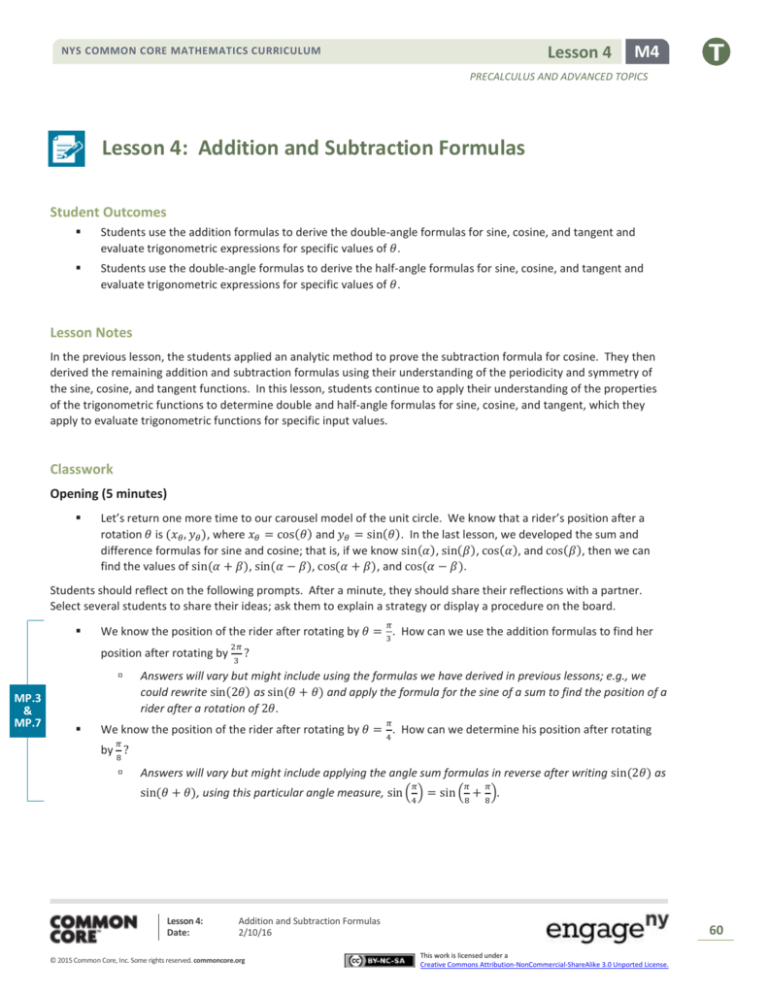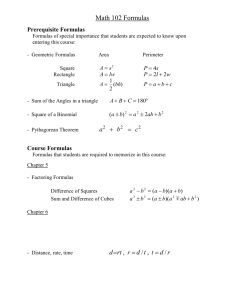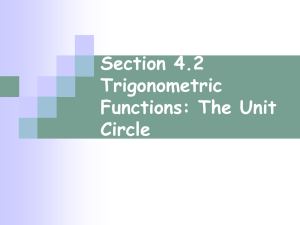
Lesson 4
NYS COMMON CORE MATHEMATICS CURRICULUM
M4
PRECALCULUS AND ADVANCED TOPICS
Lesson 4: Addition and Subtraction Formulas
Student Outcomes
Students use the addition formulas to derive the double-angle formulas for sine, cosine, and tangent and
evaluate trigonometric expressions for specific values of 𝜃.
Students use the double-angle formulas to derive the half-angle formulas for sine, cosine, and tangent and
evaluate trigonometric expressions for specific values of 𝜃.
Lesson Notes
In the previous lesson, the students applied an analytic method to prove the subtraction formula for cosine. They then
derived the remaining addition and subtraction formulas using their understanding of the periodicity and symmetry of
the sine, cosine, and tangent functions. In this lesson, students continue to apply their understanding of the properties
of the trigonometric functions to determine double and half-angle formulas for sine, cosine, and tangent, which they
apply to evaluate trigonometric functions for specific input values.
Classwork
Opening (5 minutes)
Let’s return one more time to our carousel model of the unit circle. We know that a rider’s position after a
rotation 𝜃 is (𝑥𝜃 , 𝑦𝜃 ), where 𝑥𝜃 = cos(𝜃) and 𝑦𝜃 = sin(𝜃). In the last lesson, we developed the sum and
difference formulas for sine and cosine; that is, if we know sin(𝛼), sin(𝛽), cos(𝛼), and cos(𝛽), then we can
find the values of sin(𝛼 + 𝛽), sin(𝛼 − 𝛽), cos(𝛼 + 𝛽), and cos(𝛼 − 𝛽).
Students should reflect on the following prompts. After a minute, they should share their reflections with a partner.
Select several students to share their ideas; ask them to explain a strategy or display a procedure on the board.
𝜋
We know the position of the rider after rotating by 𝜃 = . How can we use the addition formulas to find her
position after rotating by
MP.3
&
MP.7
2𝜋
3
3
?
Answers will vary but might include using the formulas we have derived in previous lessons; e.g., we
could rewrite sin(2𝜃) as sin(𝜃 + 𝜃) and apply the formula for the sine of a sum to find the position of a
rider after a rotation of 2𝜃.
𝜋
We know the position of the rider after rotating by 𝜃 = . How can we determine his position after rotating
4
𝜋
by ?
8
Answers will vary but might include applying the angle sum formulas in reverse after writing sin(2𝜃) as
𝜋
𝜋
𝜋
4
8
8
sin(𝜃 + 𝜃), using this particular angle measure, sin ( ) = sin ( + ).
Lesson 4:
Date:
Addition and Subtraction Formulas
2/10/16
© 2015 Common Core, Inc. Some rights reserved. commoncore.org
60
This work is licensed under a
Creative Commons Attribution-NonCommercial-ShareAlike 3.0 Unported License.
Lesson 4
NYS COMMON CORE MATHEMATICS CURRICULUM
M4
PRECALCULUS AND ADVANCED TOPICS
Exercise 1 (7 minutes)
Scaffolding:
In this exercise, students derive the double-angle formula for sine using the addition
formula. Allow students to struggle with this task before explaining that they apply the
sum formulas with 2𝜃 = 𝜃 + 𝜃. This provides an opportunity for them to further develop
their mathematical reasoning skills and to practice looking for structure. Students later
apply the double-angle formulas to determine the half-angle formulas, which allows them
to evaluate trigonometric functions for a larger number of input values.
Encourage advanced students
to think about ways to write
these formulas in terms of sine
or cosine only.
The exercise should be completed in pairs and then discussed in a whole-class setting after a few
minutes. Be sure to identify these formulas as the double-angle formulas for sine and cosine.
Exercises
1.
Derive formulas for the following:
a.
𝐬𝐢𝐧(𝟐𝜽)
𝐬𝐢𝐧(𝟐𝜽) = 𝐬𝐢𝐧(𝜽 + 𝜽)
= 𝐬𝐢𝐧(𝜽)𝐜𝐨𝐬(𝜽) + 𝐜𝐨𝐬(𝜽)𝐬𝐢𝐧(𝜽)
= 𝟐𝐬𝐢𝐧(𝜽)𝐜𝐨𝐬(𝜽)
MP.7
b.
𝐜𝐨𝐬(𝟐𝜽)
𝐜𝐨𝐬(𝟐𝜽) = 𝐜𝐨𝐬(𝜽 + 𝜽)
= 𝐜𝐨𝐬(𝜽)𝐜𝐨𝐬(𝜽) − 𝐬𝐢𝐧(𝜽)𝐬𝐢𝐧(𝜽)
= 𝐜𝐨𝐬 𝟐 (𝜽) − 𝐬𝐢𝐧𝟐 (𝜽)
Why was it helpful to rewrite 2𝜃 as (𝜃 + 𝜃) when deriving the double-angle formula?
While we don’t know how to find the value of sin(2𝜃) directly, we do know how to evaluate the sine of
the sum (𝜃 + 𝜃) using the formula sin(𝜃 + 𝜃) = sin(𝜃)cos(𝜃) + cos(𝜃)sin(𝜃) = 2sin(𝜃)cos(𝜃).
Our formula for calculating cos(2𝜃) is written in terms of cos 2 (𝜃) and sin2 (𝜃). Is there a way to write this
formula in terms of the cosine function only? Explain.
Yes. Since cos 2 (𝜃) + sin2 (𝜃) = 1, we can substitute sin2 (𝜃) = 1 − cos 2 (𝜃). Then
cos 2 (𝜃) − sin2 (𝜃) = cos 2 (𝜃) − (1 − cos 2 (𝜃)) = 2cos 2 (𝜃) − 1.
Can we write cos(2𝜃) in terms of the sine function only? Explain.
Yes. Since cos 2 (𝜃) + sin2 (𝜃) = 1, we can substitute cos 2 (𝜃) = 1 − sin2 (𝜃). Then
cos 2 (𝜃) − sin2 (𝜃) = (1 − sin2 (𝜃)) − sin2 (𝜃) = 1 − 2sin2 (𝜃).
Exercises 2–3 (10 minutes)
Students should complete the exercises in pairs or small groups. Each pair or small group should verify one of the
identities in Exercise 1. After a few minutes, volunteers could display their solutions. Other students should be allowed
MP.3 to offer alternative approaches or critiques. Exercise 2 could be completed in pairs or as part of a teacher-led discussion.
The discussion of Exercise 2 could include a verification, using the unit circle, of the signs on the coordinates of the
rider’s position.
Lesson 4:
Date:
Addition and Subtraction Formulas
2/10/16
© 2015 Common Core, Inc. Some rights reserved. commoncore.org
61
This work is licensed under a
Creative Commons Attribution-NonCommercial-ShareAlike 3.0 Unported License.
Lesson 4
NYS COMMON CORE MATHEMATICS CURRICULUM
M4
PRECALCULUS AND ADVANCED TOPICS
2.
Use the double-angle formulas for sine and cosine to verify these identities:
a.
𝐭𝐚𝐧(𝟐𝜽) =
𝟐𝐭𝐚𝐧(𝜽)
𝟏−𝐭𝐚𝐧𝟐 (𝜽)
𝐭𝐚𝐧(𝟐𝜽) =
𝐬𝐢𝐧(𝟐𝜽)
𝐜𝐨𝐬(𝟐𝜽)
Point students to a visual
representation of the
definition of the tangent
𝟏
𝟐𝐬𝐢𝐧(𝜽)𝐜𝐨𝐬(𝜽)
𝐜𝐨𝐬 𝟐 (𝜽)
=(
(
)
)
𝟏
𝐜𝐨𝐬 𝟐 (𝜽) − 𝐬𝐢𝐧𝟐 (𝜽)
𝟐
(𝜽)
𝐜𝐨𝐬
𝟐𝐬𝐢𝐧(𝜽)𝐜𝐨𝐬(𝜽)
𝐜𝐨𝐬 𝟐 (𝜽)
=
𝐜𝐨𝐬 𝟐 (𝜽) − 𝐬𝐢𝐧𝟐 (𝜽)
𝐜𝐨𝐬 𝟐 (𝜽)
as tan(𝜃) =
𝟐𝐬𝐢𝐧(𝜽)𝐜𝐨𝐬(𝜽)
𝐜𝐨𝐬(𝜽)𝐜𝐨𝐬(𝜽)
𝐜𝐨𝐬 𝟐 (𝜽) 𝐬𝐢𝐧𝟐 (𝜽)
−
𝐜𝐨𝐬 𝟐 (𝜽) 𝐜𝐨𝐬 𝟐 (𝜽)
𝟐𝐭𝐚𝐧(𝜽)
=
𝟏 − 𝐭𝐚𝐧𝟐 (𝜽)
𝐬𝐢𝐧𝟐 (𝜽) =
𝟏−𝐜𝐨𝐬(𝟐𝜽)
𝟐
.
Cue students to use a
procedure similar to that
used in Exercise 1 to verify
the identity in Exercise 2
part (c).
𝟏 − 𝐜𝐨𝐬(𝟐𝜽) 𝟏 − (𝟏 − 𝟐𝐬𝐢𝐧𝟐 (𝜽)) 𝟐𝐬𝐢𝐧𝟐 (𝜽)
=
=
= 𝐬𝐢𝐧𝟐 (𝜽)
𝟐
𝟐
𝟐
c.
sin(𝜃)
cos(𝜃)
Cue students to look at the
structure of the right side
of the identity in Exercise
2 part (a) to help them
simplify the expression on
the left side. For instance,
ask the students, “What
term could we divide our
expression by so the first
term in the denominator
reduces to 1?”
=
b.
Scaffolding:
𝐬𝐢𝐧(𝟑𝜽) = −𝟒𝐬𝐢𝐧𝟑 (𝜽) + 𝟑𝐬𝐢𝐧(𝜽)
𝐬𝐢𝐧(𝟑𝜽) = 𝐬𝐢𝐧(𝟐𝜽 + 𝜽)
= 𝐬𝐢𝐧(𝟐𝜽)𝐜𝐨𝐬(𝜽) + 𝐜𝐨𝐬(𝟐𝜽)𝐬𝐢𝐧(𝜽)
= 𝟐𝐬𝐢𝐧(𝜽)(𝐜𝐨𝐬(𝜽))(𝐜𝐨𝐬(𝜽)) + (𝟏 − 𝟐𝐬𝐢𝐧𝟐 (𝜽))(𝐬𝐢𝐧(𝜽))
= 𝟐𝐬𝐢𝐧(𝜽)𝐜𝐨𝐬𝟐 (𝜽) + 𝐬𝐢𝐧(𝜽) − 𝟐𝐬𝐢𝐧𝟑 (𝜽)
= 𝟐𝐬𝐢𝐧(𝜽)(𝟏 − 𝐬𝐢𝐧𝟐 (𝜽)) + 𝐬𝐢𝐧(𝜽) − 𝟐𝐬𝐢𝐧𝟑 (𝜽)
= 𝟐𝐬𝐢𝐧(𝜽) − 𝟐𝐬𝐢𝐧𝟑 (𝜽) + 𝐬𝐢𝐧(𝜽) − 𝟐𝐬𝐢𝐧𝟑 (𝜽)
= −𝟒𝐬𝐢𝐧𝟑 (𝜽) + 𝟑𝐬𝐢𝐧(𝜽)
3.
MP.2
Suppose that the position of a rider on the unit circle carousel is (𝟎. 𝟖, −𝟎. 𝟔) for a rotation 𝜽. What is the position
of the rider after rotation by 𝟐𝜽?
𝒙𝟐𝜽 = 𝐜𝐨𝐬(𝟐𝜽) = 𝐜𝐨𝐬 𝟐 (𝜽) − 𝐬𝐢𝐧𝟐 (𝜽) = 𝟎. 𝟖𝟐 − (−𝟎. 𝟔)𝟐 = 𝟎. 𝟔𝟒 − 𝟎. 𝟑𝟔 = 𝟎. 𝟐𝟖
𝒚𝟐𝜽 = 𝐬𝐢𝐧(𝟐𝜽) = 𝟐𝐬𝐢𝐧(𝜽)𝐜𝐨𝐬(𝜽) = 𝟐(−𝟎. 𝟔)(𝟎. 𝟖) = −𝟎. 𝟗𝟔
The rider’s position is (𝟎. 𝟐𝟖, −𝟎. 𝟗𝟔).
Lesson 4:
Date:
Addition and Subtraction Formulas
2/10/16
© 2015 Common Core, Inc. Some rights reserved. commoncore.org
62
This work is licensed under a
Creative Commons Attribution-NonCommercial-ShareAlike 3.0 Unported License.
Lesson 4
NYS COMMON CORE MATHEMATICS CURRICULUM
M4
PRECALCULUS AND ADVANCED TOPICS
Discussion (5 minutes)
In this example, students use the double-angle formula for cosine to derive the half-angle formula for cosine. The halfangle formula provides students with an efficient means of evaluating trigonometric functions for a wider variety of
inputs. The example should be completed as part of a teacher-led discussion.
What are some of the limitations of the formulas we have derived so far in evaluating trigonometric
expressions for specific inputs?
𝜋 𝜋 𝜋
𝜋
2 6 4
3
Since we only determined the exact values of trigonometric functions for multiples of , , , and we
are limited in the values of 𝜃 for which we can evaluate trigonometric expressions. In other words, we
can only evaluate sin(𝜃), cos(𝜃), and tan(𝜃) for values of 𝜃 that can be found by adding or subtracting
𝜋 𝜋 𝜋
𝜋
multiples of , , , and .
6 4 3
2
𝜋
𝜋
In the Opening, we thought about how we could find sin ( ) and cos ( ) since we know the values of sine and
8
𝜋
8
𝜋
cosine at . Do we have a way to evaluate sine and cosine at ?
4
Why might it be helpful to derive half-angle formulas for sine, cosine, and tangent?
8
No, not yet.
Answers will vary but should address that we could evaluate the trigonometric functions for more
values of 𝜃.
Recall that the double-angle formula for cosine is cos(2𝜃) = 2cos 2 (𝜃) − 1. How can we use this formula to
𝜋
find a value for cos ( ) ?
8
Allow students to work with a partner and struggle with this question for a minute or two before
revealing the answer.
𝜋
𝜋
We can use the double-angle formula with cos ( ) = cos (2 ⋅ ), which gives
4
𝜋
𝜋
4
8
2
8
𝜋
√2
8
2
cos ( ) = cos (2 ⋅ ) = 2 cos ( ) − 1. Then we can solve
This gives
𝜋
cos 2 ( )
8
1 √2
= (
2
2
𝜋
𝜋
8
8
= 2 cos 2 ( ) − 1 for cos ( ).
+ 1). How do we know whether or not we need the positive or negative square
𝜋
root when we solve for cos ( ) ?
8
𝜋
It will depend on the quadrant in which the initial ray lands after rotating by . Cosine is positive in
𝜋
8
Quadrants I and IV and negative in Quadrants II and III. Since rotation by terminates in Quadrant I,
8
𝜋
the value of cos ( ) is positive.
8
Exercises 4–7 (10 minutes)
Students should complete the exercises in pairs, first working on the problems independently and then verifying their
solutions with a partner. At an appropriate time, selected students should explain their solutions, including how they
determined the signs for the position coordinates in Exercise 6 and the signs for the evaluated trigonometric functions in
Exercise 7. As time permits, additional students should be encouraged to share alternative approaches to solving the
𝜋
problems; e.g., there could be multiple ways to evaluate cos ( ) in Exercise 7 part (b). Note: if calculators are available,
12
students could use them to verify their solutions and approximate the values in Exercises 6 and 7. If they are not
available, answers could be left in their exact form.
Lesson 4:
Date:
Addition and Subtraction Formulas
2/10/16
© 2015 Common Core, Inc. Some rights reserved. commoncore.org
63
This work is licensed under a
Creative Commons Attribution-NonCommercial-ShareAlike 3.0 Unported License.
Lesson 4
NYS COMMON CORE MATHEMATICS CURRICULUM
M4
PRECALCULUS AND ADVANCED TOPICS
4.
𝐜𝐨𝐬(𝜽)+𝟏
.
𝟐
𝜽
𝟐
Use the double-angle formula for cosine to establish the identity 𝐜𝐨𝐬 ( ) = ±√
𝜽
𝟐
𝜽
𝟐
𝜽
𝟐
Since 𝜽 = 𝟐 ( ), the double-angle formula gives 𝐜𝐨𝐬 (𝟐 ( )) = 𝟐𝐜𝐨𝐬 𝟐 ( ) − 𝟏. Then we
have
𝜽
𝐜𝐨𝐬(𝜽) = 𝟐𝐜𝐨𝐬 𝟐 ( ) − 𝟏
𝟐
𝜽
𝟐
𝟏 + 𝐜𝐨𝐬(𝜽) = 𝟐𝐜𝐨𝐬 ( )
𝟐
𝟏 + 𝐜𝐨𝐬(𝜽)
𝜽
𝟐
= 𝐜𝐨𝐬 ( )
𝟐
𝟐
Have advanced students
derive a formula for the
one-third angle for sine
instead of verifying the
identities in Exercise 5.
Cue students in Exercise 7
by asking them, “Is there a
way to use the addition or
subtraction formulas to
𝜽
𝐜𝐨𝐬(𝜽) + 𝟏
𝐜𝐨𝐬 ( ) = ±√
𝟐
𝟐
5.
Scaffolding:
𝜋
evaluate cos ( )?”
12
Use the double-angle formulas to verify these identities:
a.
𝜽
𝟐
𝟏−𝐜𝐨𝐬(𝜽)
𝟐
𝐬𝐢𝐧 ( ) = ±√
𝜽
𝟐
𝜽
𝟐
𝜽
𝟐
Since 𝜽 = 𝟐 ( ), the double-ange formulas give 𝐜𝐨𝐬 (𝟐 ( )) = 𝟏 − 𝟐𝐬𝐢𝐧𝟐 ( ).
Then we have
𝜽
𝟐
𝐜𝐨𝐬(𝜽) = 𝟏 − 𝟐𝐬𝐢𝐧𝟐 ( )
𝜽
𝟏 − 𝐜𝐨𝐬(𝜽) = 𝟐𝐬𝐢𝐧𝟐 ( )
𝟐
𝟏 − 𝐜𝐨𝐬(𝜽)
𝜽
= 𝐬𝐢𝐧𝟐 ( )
𝟐
𝟐
𝜽
𝟏 − 𝐜𝐨𝐬(𝜽)
𝐬𝐢𝐧 ( ) = ±√
𝟐
𝟐
b.
𝜽
𝟐
𝟏−𝐜𝐨𝐬(𝜽)
𝟏+𝐜𝐨𝐬(𝜽)
𝐭𝐚𝐧 ( ) = ±√
𝟏 − 𝐜𝐨𝐬(𝜽)
𝜽
𝐬𝐢𝐧 ( ) ±√
𝜽
𝟏 − 𝐜𝐨𝐬(𝜽)
𝟐
𝟐
𝐭𝐚𝐧 ( ) =
=
= ±√
𝜽
𝟐
𝟏 + 𝐜𝐨𝐬(𝜽)
𝐜𝐨𝐬 ( ) ±√𝐜𝐨𝐬(𝜽) + 𝟏
𝟐
𝟐
Lesson 4:
Date:
Addition and Subtraction Formulas
2/10/16
© 2015 Common Core, Inc. Some rights reserved. commoncore.org
64
This work is licensed under a
Creative Commons Attribution-NonCommercial-ShareAlike 3.0 Unported License.
Lesson 4
NYS COMMON CORE MATHEMATICS CURRICULUM
M4
PRECALCULUS AND ADVANCED TOPICS
6.
MP.2
The position of a rider on the unit circle carousel is (𝟎. 𝟖, −𝟎. 𝟔) after a rotation by 𝜽 where 𝟎 ≤ 𝜽 < 𝟐𝝅. What is
𝜽
the position of the rider after rotation by ?
𝟐
Given that 𝐜𝐨𝐬(𝜽) is positive and 𝐬𝐢𝐧(𝜽) is negative, the rider is located in Quadrant IV after rotation by 𝜽, so
𝟑𝝅
𝜽
𝟑𝝅
𝟐
<
𝜽
𝜽
𝜽 < 𝟐𝝅. This means that
< < 𝝅, which is in Quadrant II, so 𝐜𝐨𝐬 ( ) is negative and 𝐬𝐢𝐧 ( ) is positive.
𝟐
𝟐
𝟒
𝟐
𝜽
𝐜𝐨𝐬(𝜽) + 𝟏
𝟎. 𝟖 + 𝟏
𝒙𝜽 = 𝐜𝐨𝐬 ( ) = ±√
= −√
≈ −𝟎. 𝟗𝟓
𝟐
𝟐
𝟐
𝟐
𝜽
𝟏 − 𝐜𝐨𝐬(𝜽)
𝟏 − 𝟎. 𝟖
𝒚𝜽 = 𝐬𝐢𝐧 ( ) = ±√
=√
≈ 𝟎. 𝟑𝟐
𝟐
𝟐
𝟐
𝟐
𝜽
The rider’s position is approximately (−𝟎. 𝟗𝟓, 𝟎. 𝟑𝟐) after rotation by .
𝟐
7.
Evaluate the following trigonometric expressions.
a.
𝐬𝐢𝐧 (
𝟑𝝅
)
𝟖
𝝅
𝟑𝝅
𝟑𝝅
√𝟐
𝟏 − (−𝐜𝐨𝐬 ( ))
𝟑𝝅
𝟒
√𝟏 + 𝟐
√𝟏 − 𝐜𝐨𝐬 ( 𝟒 ) √
𝟒
𝐬𝐢𝐧 ( ) = 𝐬𝐢𝐧 ( ) =
=
=
≈ 𝟎. 𝟗𝟐
𝟖
𝟐
𝟐
𝟐
𝟐
b.
𝐭𝐚𝐧 (
𝝅
)
𝟐𝟒
𝐭𝐚𝐧 (
𝝅
𝝅
𝟏 − 𝐜𝐨𝐬 ( )
𝝅
𝟏𝟐
) = 𝐭𝐚𝐧 ( 𝟏𝟐 ) = √
𝝅
𝟐𝟒
𝟐
𝟏 + 𝐜𝐨𝐬 ( )
𝟏𝟐
𝐜𝐨𝐬 (
𝝅
𝝅 𝝅
𝝅
𝝅
𝝅
𝝅
𝟏 √𝟐
√𝟑 √𝟐
√𝟔 + √𝟐
) = 𝐜𝐨𝐬 ( − ) = 𝐜𝐨𝐬 ( ) 𝐜𝐨𝐬 ( ) + 𝐬𝐢𝐧 ( ) 𝐬𝐢𝐧 ( ) = ( ) +
( )=
𝟏𝟐
𝟑 𝟒
𝟑
𝟒
𝟑
𝟒
𝟐 𝟐
𝟐 𝟐
𝟒
𝐭𝐚𝐧 (
√𝟔 + √𝟐
𝟏−
𝝅
𝟒 − √𝟔 − √𝟐
𝟒
)=√
=√
≈ 𝟎. 𝟏𝟑
𝟐𝟒
+
𝟒 + √𝟔 + √𝟐
√𝟔 √𝟐
𝟏+
𝟒
Lesson 4:
Date:
Addition and Subtraction Formulas
2/10/16
© 2015 Common Core, Inc. Some rights reserved. commoncore.org
65
This work is licensed under a
Creative Commons Attribution-NonCommercial-ShareAlike 3.0 Unported License.
Lesson 4
NYS COMMON CORE MATHEMATICS CURRICULUM
M4
PRECALCULUS AND ADVANCED TOPICS
Closing (3 minutes)
Have students respond in writing to one or more of the prompts below:
Write the double-angle formulas that we studied in this lesson for sin(2𝜃), cos(2𝜃), and tan(2𝜃).
Write the half-angle formulas that we studied in this lesson for sin ( ), cos ( ), and tan ( ).
How can our understanding of the trigonometric functions help us determine the position coordinates for a
carousel rider on our unit circle model regardless of the size of the rotation 𝜃? Share your thoughts with a
partner.
Answers will vary. Possible acceptable responses could include:
𝜃
𝜃
𝜃
2
2
2
𝜋 𝜋
𝜋
6 4
3
We have found the exact position coordinates for rotations , , and .
Our understanding of the unit circle allows us to determine the position coordinates for rotations that
𝜋
are multiples of .
The double- and triple-angle formulas enable us to find position coordinates for rotations that are
𝜋 𝜋
𝜋
multiples of , , and .
The half-angle and addition/subtraction formulas enable us to find position coordinates for many other
rotational values.
2
6 4
3
Lesson Summary
The double-angle and half-angle formulas for sine, cosine, and tangent are summarized below.
For all real numbers 𝜽 for which the expressions are defined,
𝐬𝐢𝐧(𝟐𝜽) = 𝟐𝐬𝐢𝐧(𝜽)𝐜𝐨𝐬(𝜽)
𝐜𝐨𝐬(𝟐𝜽) = 𝐜𝐨𝐬 𝟐 (𝜽) − 𝐬𝐢𝐧𝟐 (𝜽)
= 𝟐𝐜𝐨𝐬 𝟐 (𝜽) − 𝟏
= 𝟏 − 𝟐𝐬𝐢𝐧𝟐 (𝜽)
𝟐𝐭𝐚𝐧(𝜽)
𝐭𝐚𝐧(𝟐𝜽) =
𝟏 − 𝐭𝐚𝐧𝟐 (𝜽)
𝜽
𝟏 − 𝐜𝐨𝐬(𝜽)
𝐬𝐢𝐧 ( ) = ±√
𝟐
𝟐
𝛉
𝐜𝐨𝐬(𝜽) + 𝟏
𝐜𝐨𝐬 ( ) = ±√
𝟐
𝟐
𝜽
𝟏 − 𝐜𝐨𝐬(𝜽)
𝐭𝐚𝐧 ( ) = ±√
𝟐
𝟏 + 𝐜𝐨𝐬(𝜽)
Exit Ticket (5 minutes)
Lesson 4:
Date:
Addition and Subtraction Formulas
2/10/16
© 2015 Common Core, Inc. Some rights reserved. commoncore.org
66
This work is licensed under a
Creative Commons Attribution-NonCommercial-ShareAlike 3.0 Unported License.
Lesson 4
NYS COMMON CORE MATHEMATICS CURRICULUM
M4
PRECALCULUS AND ADVANCED TOPICS
Name
Date
Lesson 4: Addition and Subtraction Formulas
Exit Ticket
1.
Show that cos(3𝜃) = 4cos 3 (𝜃) − 3cos(𝜃).
2.
Evaluate cos ( ) using the half-angle formula, and then verify your solution using a different formula.
7𝜋
12
Lesson 4:
Date:
Addition and Subtraction Formulas
2/10/16
© 2015 Common Core, Inc. Some rights reserved. commoncore.org
67
This work is licensed under a
Creative Commons Attribution-NonCommercial-ShareAlike 3.0 Unported License.
Lesson 4
NYS COMMON CORE MATHEMATICS CURRICULUM
M4
PRECALCULUS AND ADVANCED TOPICS
Exit Ticket Sample Solutions
1.
Show that 𝐜𝐨𝐬(𝟑𝜽) = 𝟒𝐜𝐨𝐬 𝟑 (𝜽) − 𝟑𝐜𝐨𝐬(𝜽).
𝐜𝐨𝐬(𝟑𝜽) = 𝐜𝐨𝐬(𝟐𝜽 + 𝜽) = 𝐜𝐨𝐬(𝟐𝜽)𝐜𝐨𝐬(𝜽) − 𝐬𝐢𝐧(𝟐𝜽)𝐬𝐢𝐧(𝜽)
= (𝟐𝐜𝐨𝐬 𝟐 (𝜽) − 𝟏)(𝐜𝐨𝐬(𝜽)) − 𝟐𝐬𝐢𝐧(𝜽)𝐜𝐨𝐬(𝜽)(𝐬𝐢𝐧(𝜽))
= 𝟐𝐜𝐨𝐬 𝟑 (𝜽) − 𝐜𝐨𝐬(𝜽) − 𝟐𝐬𝐢𝐧𝟐 (𝜽)𝐜𝐨𝐬(𝜽)
= 𝟐𝐜𝐨𝐬 𝟑 (𝜽) − 𝐜𝐨𝐬(𝜽) − 𝟐(𝟏 − 𝐜𝐨𝐬 𝟐 (𝜽))(𝐜𝐨𝐬(𝜽))
= 𝟐𝐜𝐨𝐬 𝟑 (𝜽) − 𝐜𝐨𝐬(𝜽) − 𝟐𝐜𝐨𝐬(𝜽) + 𝟐𝐜𝐨𝐬 𝟑 (𝜽)
= 𝟒𝐜𝐨𝐬 𝟑 (𝜽) − 𝟑𝐜𝐨𝐬(𝜽)
2.
Evaluate 𝐜𝐨𝐬 (
𝟕𝝅
) using the half-angle formula, and then verify your solution using a different formula.
𝟏𝟐
𝟕𝝅
𝟕𝝅
−√𝟑
+𝟏
𝟕𝝅
√
√𝐜𝐨𝐬 ( 𝟔 ) + 𝟏
𝐜𝐨𝐬 ( ) = 𝐜𝐨𝐬 ( 𝟔 ) = −
=− 𝟐
≈ −𝟎. 𝟐𝟔
𝟏𝟐
𝟐
𝟐
𝟐
𝟕𝝅
𝝅 𝝅
𝝅
𝝅
𝝅
𝝅
√𝟐 𝟏
√𝟐 √𝟑
√𝟐 − √𝟔
𝐜𝐨𝐬 ( ) = 𝐜𝐨𝐬 ( + ) = 𝐜𝐨𝐬 ( ) 𝐜𝐨𝐬 ( ) − 𝐬𝐢𝐧 ( ) 𝐬𝐢𝐧 ( ) =
( )−
≈ −𝟎. 𝟐𝟔
( )−
𝟏𝟐
𝟒 𝟑
𝟒
𝟑
𝟒
𝟑
𝟐 𝟐
𝟐 𝟐
𝟒
Problem Set Sample Solutions
1.
Evaluate the following trigonometric expressions.
a.
𝝅
𝟖
𝝅
𝟖
𝟐𝐬𝐢𝐧 ( ) 𝐜𝐨𝐬 ( )
𝝅
𝟒
𝐬𝐢𝐧 ( ) =
b.
𝟏
𝟐
𝟏
𝟒
c.
d.
𝐬𝐢𝐧 (
𝟐
𝝅
) 𝐜𝐨𝐬 (𝟏𝟐)
𝝅
𝟏
(𝐬𝐢𝐧 ( 𝟔)) = 𝟖
𝟒𝐬𝐢𝐧 (−
𝟓𝝅
𝟓𝝅
) 𝐜𝐨𝐬 (− )
𝟏𝟐
𝟏𝟐
𝟐𝐬𝐢𝐧 (
−𝟓𝝅
𝝅
𝟏
) = −𝟐𝐬𝐢𝐧 ( ) = −𝟐 ( ) = −𝟏
𝟔
𝟔
𝟐
𝐜𝐨𝐬 𝟐 (
𝟑𝝅
𝟑𝝅
) − 𝐬𝐢𝐧𝟐 ( )
𝟖
𝟖
𝐜𝐨𝐬 (
e.
𝝅
𝟏𝟐
√𝟐
√𝟐
𝟑𝝅
𝝅
) = −𝐜𝐨𝐬 ( ) = −
𝟒
𝟒
𝟐
𝟐𝐜𝐨𝐬 𝟐 (
𝝅
𝟔
𝝅
)−𝟏
𝟏𝟐
𝐜𝐨𝐬 ( ) =
√𝟑
Lesson 4:
Date:
𝟐
Addition and Subtraction Formulas
2/10/16
© 2015 Common Core, Inc. Some rights reserved. commoncore.org
68
This work is licensed under a
Creative Commons Attribution-NonCommercial-ShareAlike 3.0 Unported License.
Lesson 4
NYS COMMON CORE MATHEMATICS CURRICULUM
M4
PRECALCULUS AND ADVANCED TOPICS
f.
𝝅
𝟖
𝟏 − 𝟐𝐬𝐢𝐧𝟐 (− )
𝐜𝐨𝐬 (
g.
√𝟐
−𝝅
)=
𝟒
𝟐
𝐜𝐨𝐬 𝟐 (−
𝟏
𝟐
𝟏𝟏𝝅
)−𝟐
𝟏𝟐
(𝟐𝐜𝐨𝐬𝟐 (−
𝟏𝟏𝝅
𝟏𝟐
𝟑
𝟏
−𝟏𝟏𝝅
) − 𝟏) − 𝟐 = 𝟐 (𝐜𝐨𝐬 (
𝟔
𝟑
𝟏
𝝅
𝟑
𝟏 √𝟑
𝟑
)) − 𝟐 = 𝟐 (𝐜𝐨𝐬 ( 𝟔)) − 𝟐 = 𝟐 ( 𝟐 ) − 𝟐 =
√𝟑 𝟑
−
𝟒
𝟐
𝝅
𝟖
𝝅
𝟏−𝐭𝐚𝐧𝟐 ( )
𝟖
𝟐𝐭𝐚𝐧( )
h.
𝝅
𝟒
𝐭𝐚𝐧 ( ) = 𝟏
𝟓𝝅
)
𝟏𝟐
𝟓𝝅
𝟏−𝐭𝐚𝐧𝟐 (− )
𝟏𝟐
𝟐𝐭𝐚𝐧(−
i.
𝐭𝐚𝐧 (−
j.
√𝟑
𝟓𝝅
𝝅
𝟏
) = 𝐭𝐚𝐧 ( ) =
=
𝟔
𝟔
√𝟑
𝟑
𝝅
𝟖
𝐜𝐨𝐬 𝟐 ( )
𝝅
𝟖
𝐜𝐨𝐬 𝟐 ( ) =
k.
𝟏+𝐜𝐨𝐬(𝝅
𝟏+ 𝟐𝟐 𝟏 √𝟐
𝟒)
=
= +
𝟐
𝟐
𝟐
𝟒
√
𝝅
𝟖
𝐜𝐨𝐬 ( )
Rotation by 𝜽 =
𝝅
𝝅
terminates in Quadrant I; therefore, 𝐜𝐨𝐬 ( ) has a positive value.
𝟖
𝟖
𝟏+𝐜𝐨𝐬(𝝅
𝟏 √𝟐 √𝟐+√𝟐
𝟒)
=√ +
=
𝟐
𝟐
𝟒
𝟐
𝝅
𝟖
𝐜𝐨𝐬 ( ) = √
l.
𝐜𝐨𝐬 (−
𝟗𝝅
)
𝟖
Rotation by 𝜽 = −
𝐜𝐨𝐬 (−
m.
𝟗𝝅
𝟗𝝅
terminates in Quadrant III; therefore, 𝐜𝐨𝐬 (− ) has a negative value.
𝟖
𝟖
√𝟐+√𝟐
𝟏+𝐜𝐨𝐬(−𝟗𝝅
𝟏+𝐜𝐨𝐬(𝝅
𝟗𝝅
𝟏 √𝟐
𝟒)
𝟒)
) = −√
= −√
= −√ +
=−
𝟖
𝟐
𝟐
𝟐
𝟒
𝟐
𝐬𝐢𝐧𝟐 (
𝝅
)
𝟏𝟐
𝐬𝐢𝐧𝟐 (
𝟏−𝐜𝐨𝐬( 𝟔 ) 𝟏− 𝟐
𝝅
𝟏 √𝟑
)=
=
= −
𝟏𝟐
𝟐
𝟐
𝟐
𝟒
𝝅
Lesson 4:
Date:
√𝟑
Addition and Subtraction Formulas
2/10/16
© 2015 Common Core, Inc. Some rights reserved. commoncore.org
69
This work is licensed under a
Creative Commons Attribution-NonCommercial-ShareAlike 3.0 Unported License.
Lesson 4
NYS COMMON CORE MATHEMATICS CURRICULUM
M4
PRECALCULUS AND ADVANCED TOPICS
n.
𝐬𝐢𝐧 (
𝝅
)
𝟏𝟐
Rotation by 𝜽 =
𝐬𝐢𝐧 (
o.
𝝅
𝝅
terminates in Quadrant I; therefore, 𝐬𝐢𝐧 ( ) has a positive value.
𝟏𝟐
𝟏𝟐
√
√
)
𝟏−𝐜𝐨𝐬(𝝅
𝝅
𝟔 = √𝟏 + √𝟑 = 𝟐+ 𝟑
)=√
𝟏𝟐
𝟐
𝟐
𝟒
𝟐
𝐬𝐢𝐧 (−
𝟓𝝅
)
𝟏𝟐
Rotation by 𝜽 = −
𝐬𝐢𝐧 (−
p.
𝟓𝝅
𝟓𝝅
terminates in Quadrant IV; therefore 𝐬𝐢𝐧 (− ) has a negative value.
𝟏𝟐
𝟏𝟐
√
𝟏−𝐜𝐨𝐬(−𝟓𝝅
√
)
𝟏+𝐜𝐨𝐬(𝝅
𝟓𝝅
𝟔)
𝟔 = −√𝟏 + √𝟑 = − 𝟐+ 𝟑
) = −√
= −√
𝟏𝟐
𝟐
𝟐
𝟐
𝟒
𝟐
𝝅
𝟖
𝐭𝐚𝐧 ( )
Rotation by 𝜽 =
𝝅
𝟖
𝝅
𝝅
terminates in Quadrant I; therefore, 𝐭𝐚𝐧 ( ) has a positive value.
𝟖
𝟖
𝟏−𝐜𝐨𝐬(𝝅
𝟏− 𝟐
𝟐−√𝟐 √
𝟒)
= √ √𝟐𝟐 = √
= 𝟑 − 𝟐√𝟐 ≈ 𝟎. 𝟒𝟏𝟒
)
𝟏+𝐜𝐨𝐬(𝝅
𝟐+√𝟐
𝟏+ 𝟐
𝟒
√
𝐭𝐚𝐧 ( ) = √
𝝅
𝟖
𝝅
𝝅
𝟖
𝟐
𝝅
𝟏−𝐜𝐨𝐬(𝝅
𝟏− 𝟐 𝟐−√𝟐
𝟒)
= √𝟐𝟐 =
= √𝟐 − 𝟏 ≈ 𝟎. 𝟒𝟏𝟒
𝝅
√𝟐
𝐬𝐢𝐧( 𝟒 )
√
𝐭𝐚𝐧 ( ) = 𝐭𝐚𝐧 ( 𝟒 ) =
q.
𝟐
𝐬𝐢𝐧(𝝅
√𝟐
𝟒)
𝟐
=
≈ 𝟎. 𝟒𝟏𝟒
𝝅 =
𝟏+𝐜𝐨𝐬(𝟒 ) 𝟏+√𝟐 𝟐+√𝟐
𝟐
√
𝐭𝐚𝐧 ( ) = 𝐭𝐚𝐧 ( 𝟒 ) =
𝟐
𝟐
𝐭𝐚𝐧 (
𝝅
)
𝟏𝟐
𝐭𝐚𝐧 (
𝟑
)
𝟏−𝐜𝐨𝐬(𝝅
𝝅
𝟔 = √𝟏− 𝟐 = √𝟐−√𝟑 = √𝟕 − 𝟒√𝟑 ≈ 𝟎. 𝟐𝟔𝟖
)=√
√𝟑
𝟏𝟐
)
𝟏+𝐜𝐨𝐬(𝝅
𝟐+√𝟑
𝟏+ 𝟐
𝟔
𝐭𝐚𝐧 (
𝝅
𝟏
)
𝐬𝐢𝐧(𝝅
𝝅
𝟏
𝟔
) = 𝐭𝐚𝐧 ( 𝟔 ) =
= 𝟐√𝟑 =
= 𝟐 − √𝟑 ≈ 𝟎. 𝟐𝟔𝟖
𝝅
𝟏𝟐
𝟐
𝟏+𝐜𝐨𝐬(𝟔 ) 𝟏+
𝟐+√𝟑
𝟐
𝐭𝐚𝐧 (
𝝅
𝟑
)
𝟏−𝐜𝐨𝐬(𝝅
𝝅
𝟔 = 𝟏− 𝟐 = 𝟐 −
) = 𝐭𝐚𝐧 ( 𝟔 ) =
√𝟑 ≈ 𝟎. 𝟐𝟔𝟖
𝟏
𝟏𝟐
𝟐
)
𝐬𝐢𝐧(𝝅
𝟔
√
√
𝟐
Lesson 4:
Date:
Addition and Subtraction Formulas
2/10/16
© 2015 Common Core, Inc. Some rights reserved. commoncore.org
70
This work is licensed under a
Creative Commons Attribution-NonCommercial-ShareAlike 3.0 Unported License.
Lesson 4
NYS COMMON CORE MATHEMATICS CURRICULUM
M4
PRECALCULUS AND ADVANCED TOPICS
r.
𝐭𝐚𝐧 (−
𝟑𝝅
)
𝟖
Rotation by 𝜽 = −
𝐭𝐚𝐧 (−
𝟑𝝅
𝟑𝝅
terminates in Quadrant IV; therefore, 𝐭𝐚𝐧 (− ) has a negative value.
𝟖
𝟖
√
𝟏−𝐜𝐨𝐬(−𝟑𝝅
𝟏+𝐜𝐨𝐬(𝝅
𝟏+ 𝟐𝟐
𝟑𝝅
𝟐+√𝟐
𝟒)
𝟒)
) = −√
=
−√
=
−√
= −√
= −√𝟑 + 𝟐√𝟐 ≈ −𝟐. 𝟒𝟏𝟒
𝝅
√
𝟖
𝟏−𝐜𝐨𝐬(𝟒 )
𝟐−√𝟐
𝟏+𝐜𝐨𝐬(−𝟑𝝅)
𝟏− 𝟐
𝟒
𝟐
𝐭𝐚𝐧 (−
𝟑𝝅
𝟑𝝅
√𝟐
𝐬𝐢𝐧 (− )
−
−
𝟑𝝅
𝟒
𝟐 = −√𝟐 ≈ −𝟐. 𝟒𝟏𝟒
) = 𝐭𝐚𝐧 ( 𝟒 ) =
=
𝟑𝝅
𝟖
𝟐
𝟏 + 𝐜𝐨𝐬 (− ) 𝟏 − √𝟐 𝟐 − √𝟐
𝟒
𝟐
𝐭𝐚𝐧 (−
𝟏−𝐜𝐨𝐬(− 𝟒 ) 𝟏+ 𝟐 𝟐+√𝟐
−𝟑𝝅
𝟑𝝅
) = 𝐭𝐚𝐧 ( 𝟒 ) =
= √𝟐𝟐 =
= −√𝟐 − 𝟏 ≈ −𝟐. 𝟒𝟏𝟒
𝟖
𝟐
−√𝟐
𝐬𝐢𝐧(−𝟑𝝅)
−
𝟑𝝅
𝟒
2.
√
𝟐
Show that 𝐬𝐢𝐧(𝟑𝒙) = 𝟑𝐬𝐢𝐧(𝒙)𝐜𝐨𝐬 𝟐 (𝒙) − 𝐬𝐢𝐧𝟑 (𝒙). (Hint: Use 𝐬𝐢𝐧(𝟐𝒙) = 𝟐𝐬𝐢𝐧(𝒙)𝐜𝐨𝐬(𝒙) and the sine sum formula.)
𝐬𝐢𝐧(𝟑𝒙) = 𝐬𝐢𝐧(𝒙 + (𝟐𝒙))
= 𝐬𝐢𝐧(𝒙)𝐜𝐨𝐬(𝟐𝒙) + 𝐜𝐨𝐬(𝒙)𝐬𝐢𝐧(𝟐𝒙)
= 𝐬𝐢𝐧(𝒙)[𝐜𝐨𝐬 𝟐 (𝒙) − 𝐬𝐢𝐧𝟐 (𝒙)] + 𝐜𝐨𝐬(𝒙)[𝟐𝐬𝐢𝐧(𝒙)𝐜𝐨𝐬(𝒙)]
= 𝐬𝐢𝐧(𝒙)𝐜𝐨𝐬𝟐 (𝒙) − 𝐬𝐢𝐧𝟑 (𝒙) + 𝟐𝐬𝐢𝐧(𝒙)𝐜𝐨𝐬 𝟐 (𝒙)
= 𝟑𝐬𝐢𝐧(𝒙)𝐜𝐨𝐬𝟐 (𝒙) − 𝐬𝐢𝐧𝟑 (𝒙)
3.
Show that 𝐜𝐨𝐬(𝟑𝒙) = 𝐜𝐨𝐬 𝟑 (𝒙) − 𝟑𝐬𝐢𝐧𝟐 (𝒙)𝐜𝐨𝐬(𝒙). (Hint: Use 𝐜𝐨𝐬(𝟐𝒙) = 𝐜𝐨𝐬 𝟐 (𝒙) − 𝐬𝐢𝐧𝟐 (𝒙) and the cosine sum
formula.)
𝐜𝐨𝐬(𝟑𝒙) = 𝐜𝐨𝐬(𝒙 + (𝟐𝒙))
= 𝐜𝐨𝐬(𝒙)𝐜𝐨𝐬(𝟐𝒙) − 𝐬𝐢𝐧(𝒙)𝐬𝐢𝐧(𝟐𝒙)
= 𝐜𝐨𝐬(𝒙)[𝐜𝐨𝐬 𝟐 (𝒙) − 𝐬𝐢𝐧𝟐 (𝒙)] − 𝐬𝐢𝐧(𝒙)[𝟐𝐬𝐢𝐧(𝒙)𝐜𝐨𝐬(𝒙)]
= 𝐜𝐨𝐬 𝟑 (𝒙) − 𝐜𝐨𝐬(𝒙)𝐬𝐢𝐧𝟐 (𝒙) − 𝟐𝐜𝐨𝐬(𝒙)𝐬𝐢𝐧𝟐 (𝒙)
= 𝐜𝐨𝐬 𝟑 (𝒙) − 𝟑𝐜𝐨𝐬(𝒙)𝐬𝐢𝐧𝟐 (𝒙)
4.
Use 𝐜𝐨𝐬(𝟐𝒙) = 𝐜𝐨𝐬 𝟐 (𝒙) − 𝐬𝐢𝐧𝟐 (𝒙) to establish the following formulas.
a.
𝐜𝐨𝐬 𝟐 (𝒙) =
𝟏+𝐜𝐨𝐬(𝟐𝒙)
𝟐
𝐜𝐨𝐬(𝟐𝒙) = 𝐜𝐨𝐬 𝟐 (𝒙) − 𝐬𝐢𝐧𝟐 (𝒙)
= 𝐜𝐨𝐬 𝟐 (𝒙) − (𝟏 − 𝐜𝐨𝐬 𝟐 (𝒙))
= 𝟐𝐜𝐨𝐬 𝟐 (𝒙) − 𝟏
Therefore, 𝐜𝐨𝐬 𝟐 (𝒙) =
b.
𝐬𝐢𝐧𝟐 (𝒙) =
𝟏+𝐜𝐨𝐬(𝟐𝒙)
.
𝟐
𝟏−𝐜𝐨𝐬(𝟐𝒙)
.
𝟐
𝐜𝐨𝐬(𝟐𝒙) = 𝐜𝐨𝐬 𝟐 (𝒙) − 𝐬𝐢𝐧𝟐 (𝒙)
= (𝟏 − 𝐬𝐢𝐧𝟐 (𝒙)) − 𝐬𝐢𝐧𝟐 (𝒙)
= 𝟏 − 𝟐𝐬𝐢𝐧𝟐 (𝒙)
Therefore, 𝐬𝐢𝐧𝟐 (𝒙) =
Lesson 4:
Date:
𝟏−𝐜𝐨𝐬(𝟐𝒙)
.
𝟐
Addition and Subtraction Formulas
2/10/16
© 2015 Common Core, Inc. Some rights reserved. commoncore.org
71
This work is licensed under a
Creative Commons Attribution-NonCommercial-ShareAlike 3.0 Unported License.
Lesson 4
NYS COMMON CORE MATHEMATICS CURRICULUM
M4
PRECALCULUS AND ADVANCED TOPICS
5.
𝜽
𝟐
Jamia says that because sine is an odd function, 𝐬𝐢𝐧 ( ) is always negative if 𝜽 is negative. That is, she says that for
𝟏−𝐜𝐨𝐬(𝜽)
. Is she correct? Explain how you know.
𝟐
𝜽
𝟐
negative values of 𝐬𝐢𝐧 ( ) = −√
Jamia is not correct. Consider 𝜽 = −
Thus, 𝐬𝐢𝐧 (−
6.
𝟕𝝅
) is positive.
𝟔
𝜽
𝟕𝝅
𝟕𝝅
𝟕𝝅
. In this case, = − , and rotation by –
terminates in Quadrant II.
𝟑
𝟔
𝟐
𝟔
𝝅
𝝅 𝝅
𝝅
) is using the difference formula for sine since
= − . Fred
𝟏𝟐
𝟏𝟐
𝟑
𝟒
𝝅
says that there is another way to calculate 𝐬𝐢𝐧 ( ). Who is correct, and why?
𝟏𝟐
Ginger says that the only way to calculate 𝐬𝐢𝐧 (
Fred is correct. We can use the half-angle formula with 𝜽 =
7.
𝝅
𝝅
to calculate 𝐬𝐢𝐧 ( ).
𝟔
𝟏𝟐
𝜽
𝒏
Henry says that by repeatedly applying the half-angle formula for sine we can create a formula for 𝐬𝐢𝐧 ( ) for any
positive integer 𝒏. Is he correct? Explain how you know.
𝜽
𝒌 ) for positive integers 𝒌. There is
𝟐
Henry is not correct. Repeating this process will only give us formulas for 𝐬𝐢𝐧 (
𝜽
𝟓
no way to derive a formula for quantities such as 𝐬𝐢𝐧 ( ) using this method.
Lesson 4:
Date:
Addition and Subtraction Formulas
2/10/16
© 2015 Common Core, Inc. Some rights reserved. commoncore.org
72
This work is licensed under a
Creative Commons Attribution-NonCommercial-ShareAlike 3.0 Unported License.





